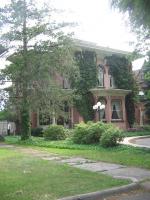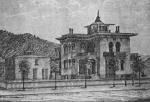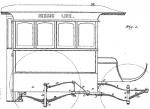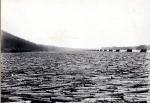![header=[Marker Text] body=[Owner, lumber mills, and president, Susquehanna Boom. A key player in making this city the "lumber capital of the world." He invented the "herdic," a rear-entry carriage, and erected many buildings here on Millionaire's Row. His 1854 home is No. 407. ] sign](http://explorepahistory.com/kora/files/1/10/1-A-334-139-ExplorePAHistory-a0l2p7-a_450.jpg)
Mouse over for marker text
Name:
Peter Herdic (1824-1888)
Region:
Valleys of the Susquehanna
County:
Lycoming
Marker Location:
407 W. 4th St., Williamsport
Dedication Date:
January 7, 1996
Behind the Marker
Pennsylvania, or "Penn's Woods," has been known since its founding for its large stretches of unbroken forests and pine-covered mountains. The lands William Penn and Quaker settlers explored in the 1680s must have been an intimidating sight. In an era when most buildings were made from and heated with wood, trees were an extremely valuable resource, but an enormous amount of labor was required to cut, saw, and transport wood. In the colonial era, wood was usually a by-product of efforts to clear land for farming.
By the early 1800s, Pennsylvania farmer-lumberjacks had expanded their efforts to the central counties of the state. Small operators timbered limited amounts of trees, loaded them onto wooden rafts, and floated them downstream to small mills where they were sawn and the lumber sold locally.
This changed when Major James H. Perkins's Susquehanna Boom Company established a boom at Williamsport by 1851. A boom was a string of chained logs that spanned a river and caught logs that came from upstream. Companies branded their logs before floating to make sorting easier at the other end. Other technological innovations, the railroad and steam-powered saw mills, encouraged lumber entrepreneurs to descend on north-central Pennsylvania.
Williamsport by 1851. A boom was a string of chained logs that spanned a river and caught logs that came from upstream. Companies branded their logs before floating to make sorting easier at the other end. Other technological innovations, the railroad and steam-powered saw mills, encouraged lumber entrepreneurs to descend on north-central Pennsylvania.
The promise of lumber riches brought Peter Herdic to Pennsylvania. Born in Fort Plains, New York, in 1824, he experienced the hard work of farm life as a young man. After working briefly at a New York sawmill in 1844, Herdic decided to try his luck in Pennsylvania. By 1846, he and partner William Andress owned shares in a shingle mill nine miles north of Williamsport in Cogan House Township, Lycoming County. Three years later he bought a woodlot and sawmill of his own. In 1853, Herdic and his wife moved to Williamsport where his career blossomed.
His coming coincided with the arrival of a rail line in Williamsport, then home to less than 2,000 people. Herdic correctly sensed that a boom was around the corner and began buying up as much property as he could, including building lots, woodlots, and sites for sawmills. He also bought enormous tracts of timberland. At one point, he was the sole owner of 54,000 acres of timberland in Cameron, Clinton, Potter, Tioga, and Lycoming counties.
In 1857, he and two other local businessmen purchased the Susquehanna Boom Company from James Perkins. Using his political influence, Herdic then convinced the legislature to raise boom tolls from $.50 to $1.25 per thousand feet of logs. In its peak year in 1873, the boom processed nearly 320 million feet of logs, earning considerable profits for Herdic and his partners.
In 1869, Herdic was elected mayor of the new city of Williamsport. At the same time he owned the gas works and sold land to the railroads to bring them into the city (routing them through other Herdic property to increase its value). He built office buildings, a waterworks, an urban railway, and a bridge over the Susquehanna River. Herdic also owned the newspaper. In addition to his business enterprises, he donated homes to the working class, erected churches on donated land, and constructed public buildings and signed them over to the city. Some sources claim his philanthropic activities severely depleted his finances and that he hovered between wealth and ruin on a yearly basis.
The man who built the Millionaires' Row mansions was hurt badly in the 1873 financial panic. He never recovered and filed for bankruptcy in 1878. Over the next ten years, Herdic developed waterworks in Pennsylvania and Illinois. On March 2, 1888, he died after falling on ice and fracturing his skull.
Herdic's death came a year before a catastrophic flood that hastened the decline of the lumber industry in the area. The June 1889 flood was the worst in the history of the Susquehanna, inundating large parts of Williamsport and Lock Haven. More importantly, it wiped out bridges and broke the Williamsport boom, sending 150 million feet of logs downriver along with several saw mills.
Williamsport, through the activities of Peter Herdic and other entrepreneurs, was the leading lumber city in the world from 1870 to 1890. After the devastating flood, many mill owners did not rebuild because of the decreasing wood supply in the region. The center of the industry moved westward as did future lumber giants Frederick Weyerhaeuser, William E. Dodge, and Harry McCormick.
By the early 1800s, Pennsylvania farmer-lumberjacks had expanded their efforts to the central counties of the state. Small operators timbered limited amounts of trees, loaded them onto wooden rafts, and floated them downstream to small mills where they were sawn and the lumber sold locally.
This changed when Major James H. Perkins's Susquehanna Boom Company established a boom at
The promise of lumber riches brought Peter Herdic to Pennsylvania. Born in Fort Plains, New York, in 1824, he experienced the hard work of farm life as a young man. After working briefly at a New York sawmill in 1844, Herdic decided to try his luck in Pennsylvania. By 1846, he and partner William Andress owned shares in a shingle mill nine miles north of Williamsport in Cogan House Township, Lycoming County. Three years later he bought a woodlot and sawmill of his own. In 1853, Herdic and his wife moved to Williamsport where his career blossomed.
His coming coincided with the arrival of a rail line in Williamsport, then home to less than 2,000 people. Herdic correctly sensed that a boom was around the corner and began buying up as much property as he could, including building lots, woodlots, and sites for sawmills. He also bought enormous tracts of timberland. At one point, he was the sole owner of 54,000 acres of timberland in Cameron, Clinton, Potter, Tioga, and Lycoming counties.
In 1857, he and two other local businessmen purchased the Susquehanna Boom Company from James Perkins. Using his political influence, Herdic then convinced the legislature to raise boom tolls from $.50 to $1.25 per thousand feet of logs. In its peak year in 1873, the boom processed nearly 320 million feet of logs, earning considerable profits for Herdic and his partners.
In 1869, Herdic was elected mayor of the new city of Williamsport. At the same time he owned the gas works and sold land to the railroads to bring them into the city (routing them through other Herdic property to increase its value). He built office buildings, a waterworks, an urban railway, and a bridge over the Susquehanna River. Herdic also owned the newspaper. In addition to his business enterprises, he donated homes to the working class, erected churches on donated land, and constructed public buildings and signed them over to the city. Some sources claim his philanthropic activities severely depleted his finances and that he hovered between wealth and ruin on a yearly basis.
The man who built the Millionaires' Row mansions was hurt badly in the 1873 financial panic. He never recovered and filed for bankruptcy in 1878. Over the next ten years, Herdic developed waterworks in Pennsylvania and Illinois. On March 2, 1888, he died after falling on ice and fracturing his skull.
Herdic's death came a year before a catastrophic flood that hastened the decline of the lumber industry in the area. The June 1889 flood was the worst in the history of the Susquehanna, inundating large parts of Williamsport and Lock Haven. More importantly, it wiped out bridges and broke the Williamsport boom, sending 150 million feet of logs downriver along with several saw mills.
Williamsport, through the activities of Peter Herdic and other entrepreneurs, was the leading lumber city in the world from 1870 to 1890. After the devastating flood, many mill owners did not rebuild because of the decreasing wood supply in the region. The center of the industry moved westward as did future lumber giants Frederick Weyerhaeuser, William E. Dodge, and Harry McCormick.
Beyond the Marker










